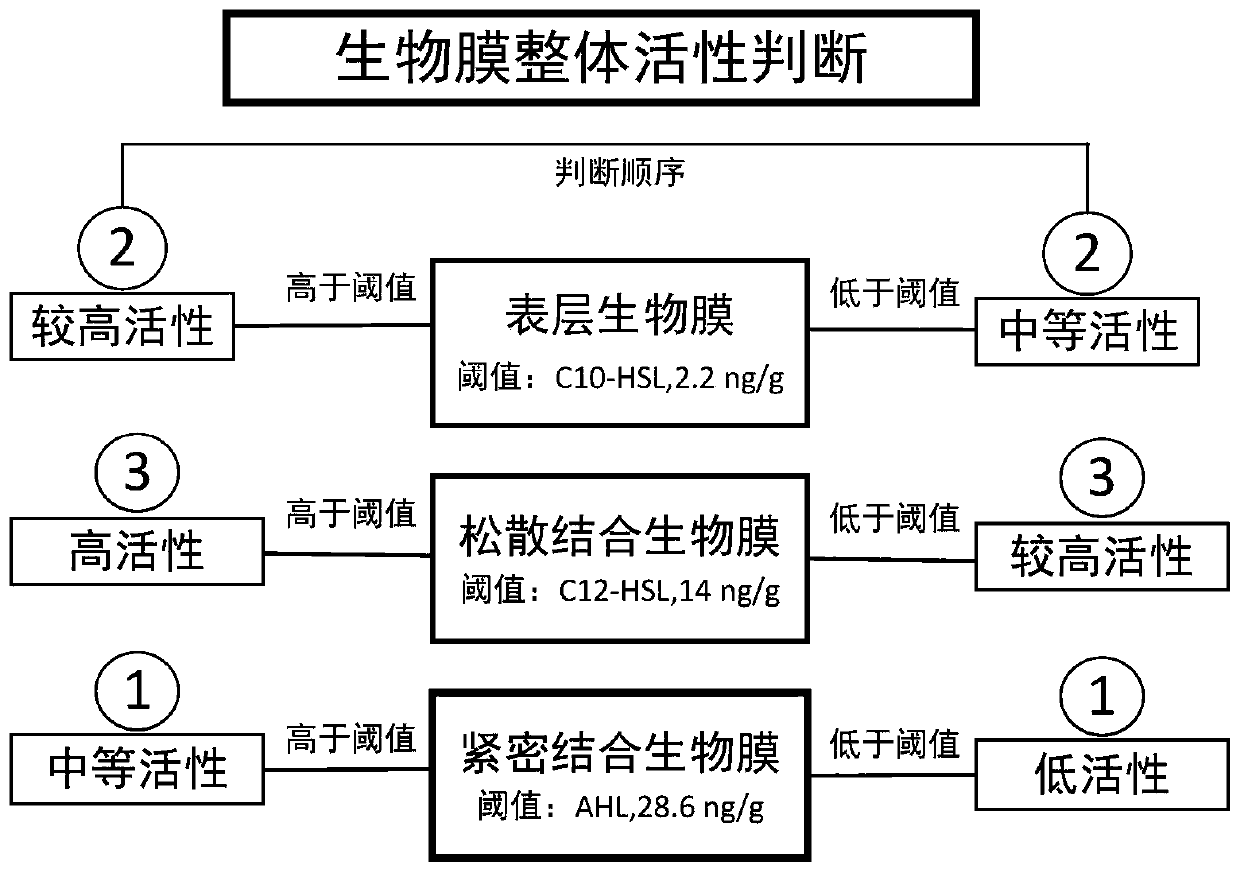A method for systematically discriminating biofilm activity in wastewater treatment systems
A treatment system and biofilm technology, which is applied in the field of systematic identification of biofilm activity in wastewater treatment systems, can solve the problems of incomplete biofilm activity measurement methods, and achieve intuitive results, intuitive analysis results, and high sensitivity.
- Summary
- Abstract
- Description
- Claims
- Application Information
AI Technical Summary
Problems solved by technology
Method used
Image
Examples
Embodiment 1
[0057] In this example, the biofilm activity detection of an industrial wastewater aerobic unit annular packing (2.5 cm in diameter) is carried out. The influent water quality in this system is: pH: 7.20-7.85, chemical oxygen demand is 1200-2800mg / L, ammonia nitrogen concentration is 2.85-11.54mg / L, total nitrogen concentration is 64-79mg / L, and total phosphorus concentration is 12.8 ~28.1mg / L.
[0058] The specific implementation process of this example is:
[0059] 1) Sampling the biofilm of the target filler: put it in a 4°C sampling box, and bring it back to the laboratory for analysis within 2 hours;
[0060] 2) Analyze the target biofilm into biofilms of different binding forms, the specific steps are as follows:
[0061] a. Drain the water on the surface of the filler, and the draining time is 30s;
[0062] b. Select the diameter of the fixed tube to be 2.5cm;
[0063] c. Put the filler into the fixed tube, place a single filler in a single fixed tube, and repeat th...
Embodiment 2
[0076] In this example, the biofilm activity detection of the aerobic unit annular filler (2.5 cm in diameter) in a certain domestic sewage is carried out. The water quality in the system is: pH: 7.0-7.55, chemical oxygen demand 220-380mg / L, ammonia nitrogen concentration 38.5-61.54mg / L, total nitrogen concentration 67.2-79mg / L, total phosphorus concentration 3.8 ~8.1mg / L.
[0077] The specific implementation process of this example is:
[0078] 1) Sampling the biofilm of the target filler: put it in a 4°C sampling box, and bring it back to the laboratory for analysis within 2 hours;
[0079] 2) Analyze the target biofilm into biofilms of different binding forms, the specific steps are as follows:
[0080] a. Drain the water on the surface of the filler, and the draining time is 40s;
[0081] b. Select the diameter of the fixed tube to be 2.5cm;
[0082] c. Put the filler into the fixed tube, place a single filler in a single fixed tube, and repeat the fixed tube 15 times;...
Embodiment 3
[0095] In this example, the biofilm activity detection of the aerobic unit annular packing (2.5 cm in diameter) in wastewater from a industrial park is carried out. The water quality in the system is: pH: 7.30-8.05, chemical oxygen demand 2200-3400mg / L, ammonia nitrogen concentration 12.85-32.54mg / L, total nitrogen concentration 84-99mg / L, total phosphorus concentration 22.8 ~38.1mg / L.
[0096] The specific implementation process of this example is:
[0097] 1) Sampling the biofilm of the target filler: put it in a 4°C sampling box, and bring it back to the laboratory for analysis within 2 hours;
[0098] 2) Analyzing the target biofilm into biofilms of different binding forms, the specific steps are as follows:
[0099] a. Drain the water on the surface of the filler, and the draining time is 30s;
[0100] b. Select the diameter of the fixed tube to be 2.5cm;
[0101] c. Put the filler into the fixed tube, place a single filler in a single fixed tube, and repeat the fixed...
PUM
| Property | Measurement | Unit |
|---|---|---|
| diameter | aaaaa | aaaaa |
Abstract
Description
Claims
Application Information
 Login to View More
Login to View More - R&D
- Intellectual Property
- Life Sciences
- Materials
- Tech Scout
- Unparalleled Data Quality
- Higher Quality Content
- 60% Fewer Hallucinations
Browse by: Latest US Patents, China's latest patents, Technical Efficacy Thesaurus, Application Domain, Technology Topic, Popular Technical Reports.
© 2025 PatSnap. All rights reserved.Legal|Privacy policy|Modern Slavery Act Transparency Statement|Sitemap|About US| Contact US: help@patsnap.com

